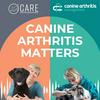67 afleveringen

Episode 67 - Understanding Pain Through a Training Perspective - Jessie Kasper
06-1-2026 | 1 u. 17 Min.
In this episode of Canine Arthritis Matters, Hannah Capon is joined by dog behaviour consultant and trainer Jessie Kasper from Mindful Methods Training. Together they explore the intersection between dog training and pain, and how physical discomfort can influence behaviour, learning, and training outcomes.Jessie shares examples from her own casework, highlighting common behavioural clues that may indicate pain, and discusses how trainers and caregivers can work more collaboratively with veterinary professionals. The conversation also covers osteoarthritis in training cases, challenges in moving from suspicion to management, and the importance of education and empathy when supporting dogs living with chronic pain.Guest BioJessie Kasper is a Certified Dog Behaviour Consultant through the International Association of Animal Behaviour Consultants and a certified Family Dog Mediator. She is Fear Free Certified, an Emotional CPR Certified Practitioner, and a CAMadvocate Level 1. Jessie runs Mindful Methods Training, where she focuses on compassionate, science-informed training approaches that consider the whole dog, including physical health, emotional wellbeing, and cognitive needs.More about Jessie and her work:https://www.mindfulmethodstraining.comKey Takeaways1. Pain can significantly interfere with dog training by affecting focus, motivation, and emotional regulation.2. Many behaviour cases have an underlying pain component, even when physical signs are subtle or easily missed.3. Collaboration between trainers, caregivers, and veterinary professionals leads to better welfare and training outcomes.4. Behavioural changes such as avoidance, inconsistency, or reduced engagement can be important clues to physical discomfort.5. Educating caregivers about the link between pain and behaviour supports earlier intervention and more realistic expectations.Relevant LinksMindful Methods Training: https://www.mindfulmethodstraining.com/CAM Member Zone: https://www.caninearthritis.co.uk/member-zone/Suspicion of Chronic Pain Form: https://caninearthritis.co.uk/suspicion-of-chronic-pain/CAM Vet Nurse Arthritis Flip Chart: https://www.caninearthritis.co.uk/product/oa-flipchart/Young Dog Joint Care Coursehttps://www.mindfulmethodstraining.com/Learn more about Jessie’s work and access resources supporting young dog joint care and pain-aware training at:https://www.mindfulmethodstraining.com/Join the CAM Member Zone to access practical tools such as the Good Day / Bad Day Diary, monitoring resources, and education to support dogs living with chronic pain:https://www.caninearthritis.co.uk/member-zone/

Episode 66 - Beyond Pain Relief: How Hydrogels May Shift the OA Management Paradigm - Jason Lowe
23-12-2025 | 1 u. 20 Min.
In this episode, Hannah is joined by Dr Jason Lowe, Chief Veterinary Officer at Contura Vet, to explore the use of intra articular hydrogels as a tool in osteoarthritis management, with a specific focus on Arthramid and how this technology may influence synovitis, joint function, pain, and longer term outcomes. Starting with a clear refresher on osteoarthritis pathology, the conversation then moves into how a 2.5% polyacrylamide hydrogel can integrate with synovial tissues and why that might matter clinically. They discuss where the evidence currently sits, what licensing and real world data can and cannot tell us, and why careful case selection remains essential. Practical caveats are emphasised, including the need for appropriate imaging, the realities of sedation or GA for administration, and the importance of rehabilitation to address established physical consequences of OA. The episode closes with broader, big picture OA management takeaways for both vets and caregivers, with actionable tips focused on monitoring, decision making, and building a sustainable plan for the individual dog.Guest BioDr. Jason Lowe is a respected equine veterinarian and until recently based in Cambridge, New Zealand. With a profound passion for horses and a commitment to their well-being, Dr. Lowe has over 30 years of clinical experience in specialist equine clinics throughout the world. After obtaining his veterinary degree from Massey University, New Zealand, Dr. Lowe embarked on a journey to specialize in equine medicine. He completed a Certificate in Equine Practice from the Royal College, London and a Masters in Business Administration from Waikato University, New Zealand.Key Takehomes1. OA is more than cartilage wear and tear. Synovitis and the wider joint environment matter, which is why targeted intra articular approaches are of interest.2. Hydrogels are not a magic reset. They may support the synovial environment and joint function, but they do not rebuild established biomechanical change on their own. Rehab and time still do the heavy lifting.3. Evidence is promising but must be interpreted with discipline. Real world and observational data can be useful, but study design, outcome measures, and time horizons influence what you can conclude.4. Case selection and process are part of the treatment. Imaging, sedation or GA suitability, expectations setting, and a whole dog plan determine whether the option makes sense for that specific patient.5. OA management remains multi modal. Even if hydrogels help, they sit within a broader strategy including monitoring, weight optimisation, movement plans, pain control where needed, and caregiver education.Relevant Links Arthramid (overview): https://arthramid.com/Arthramid product page (2.5% iPAAG): https://arthramid.com/product/Contura animal health (veterinary orthopaedics): https://contura.com/animal-health/Arthrosamid (human equivalent): https://arthrosamid.com/Contura announcement including Dr Jason Lowe appointment: https://arthramid.com/2024/07/contura-animal-health-holdings-acquires-innovative-medical-solutions/If you are a caregiver and you are unsure whether pain is part of your dog’s picture, take CAM’s free course Is My Dog in Pain? to learn the common and the subtle signs, and how to gather useful videos and notes for your next vet consult: https://www.cameducation.co.uk/course/is-my-dog-in-painLearn more about CAM:Facebook: https://www.facebook.com/CAMarthritisInstagram: https://www.instagram.com/canine_arthritisYoutube: https://www.youtube.com/c/CanineArthritisManagementLinkedIn: https://www.linkedin.com/company/canine-arthritis-management-ltdHave questions send them to: [email protected] tuned to learn how early detection can make a significant difference in managing OA in younger dogs.

Episode 65 - From Reactive to Proactive: A New Model for Canine Health - Matt Gurney
16-12-2025 | 50 Min.
In this episode of Canine Arthritis Matters, Hannah speaks with Dr Matt Gurney about Pawra (https://pawra.com), a new canine wellness centre in Chiswick, London, designed to complement a dog’s primary veterinary care rather than replace it. They explore the growing “wellness gap” between annual vet visits and problem driven consultations, and how Pawra aims to fill this space with evidence informed services focused on prevention, rehabilitation and early detection.Matt explains Pawra’s 90 minute Wellness Assessment (https://pawra.com/wellness-assessment/), the four pillars of care (Stay Well, Stay Fit, Stay Sharp, Recover), and why clear referral pathways and collaboration with a dog’s own vet are essential for safe and effective care. The conversation then moves into osteoarthritis, covering diagnosis, muscle assessment, physiotherapy, environmental changes and why proactive care is critical for long term quality of life.Guest bioDr Matt Gurney is a UK based veterinary anaesthetist and analgesia specialist. He trained at the University of Liverpool, works at Eastcott Referrals (https://www.eastcottreferrals.co.uk), and is Veterinary Lead at Pawra (https://pawra.com). Matt lectures internationally on pain management, has authored numerous publications in veterinary anaesthesia and analgesia, is Past President of the European College of Veterinary Anaesthesia and Analgesia, and was awarded Fellowship of the Royal College of Veterinary Surgeons for meritorious contribution to clinical practice.5 key takehomes1. Pawra is designed to complement, not compete with, your vet by focusing on personalised prevention, rehabilitation and early issue detection (https://pawra.com/services/).2. The Pawra Wellness Assessment provides structured, practical actions for caregivers, the home environment and the primary vet.3. Pain, physiotherapy and behaviour services should follow referral pathways to ensure the full medical history is considered and patient safety is prioritised.4. Proactive care matters, common issues like dental disease and obesity are widespread and often improveable when identified early.5. Effective osteoarthritis management relies on evidence based frameworks such as the COAST staging tool, accurate diagnosis, muscle assessment, physiotherapy guided exercise, weight optimisation and environmental changes like flooring.Relevant linksPawra website: https://pawra.comPawra services overview: https://pawra.com/services/Pawra centre and facilities: https://pawra.com/our-centre/Pawra contact and location: https://pawra.com/contact-us/COAST resourcesCOAST staging tool PDF:https://assets.elanco.com/0cec44ed-3eaa-0009-2029-666567e7e4de/b2d5f58c-2645-46ad-b5e5-65906b491bf3/COAST%20Printable%20PDF.pdfCOAST publication PDF:https://assets.elanco.com/0cec44ed-3eaa-0009-2029-666567e7e4de/fde5d152-6471-4916-af01-550ae49873c6/COAST_Publication.pdfThe Pain Vet: https://thepainvet.co.ukCAM EssentialsIf you are a caregiver or professional wanting a clear, practical and evidence based framework for recognising osteoarthritis pain and building a management plan with your vet team, explore the Canine Arthritis Essentials course here:https://www.cameducation.co.uk/course/camessentialsLearn more about CAM:Facebook: https://www.facebook.com/CAMarthritisInstagram: https://www.instagram.com/canine_arthritisYoutube: https://www.youtube.com/c/CanineArthritisManagementLinkedIn: https://www.linkedin.com/company/canine-arthritis-management-ltdHave questions send them to: [email protected] tuned to learn how early detection can make a significant difference in managing OA in younger dogs.

Podcast 64 - How do you know when you are doing enough for your arthritic dog? - Chelsea Dawson
09-12-2025 | 1 u.
In this episode, Hannah and Dr Chelsea Dawson talk about a question many owners quietly struggle with: “When is what I’m doing enough?” They explore multimodal management for canine arthritis, why it can feel overwhelming to see so many possible treatments and therapies, and how this can trigger guilt, shame or a sense of failure when you cannot do everything. Chelsea and Hannah focus on aligning your multimodal plan with your dog’s needs, your resources and your life, so that you can feel confident and kinder to yourself while still giving your dog good, evidence-based care.Guest BioDr Chelsea Dawson has a long history in animal welfare. Before becoming a vet, she worked in several roles with the OSPCA, including as an animal control officer, then trained as a veterinary nurse. She later moved to the UK to study at the University of Glasgow Veterinary School and, after graduation, practised in Lancashire, where she obtained an ESVPS certificate in Chronic Pain Management and Western Veterinary Acupuncture. She went on to run a dedicated pain clinic and developed a strong interest in holistic, integrated care. Today she works as an integrative veterinarian and veterinary herbalist, providing referral services for pain management and herbal medicine, and teaching on acupuncture and herbal medicine courses. Key Takehomes1. Multimodal management is ideal, but you do not have to do “everything” for it to be effective.2. Feelings of guilt and “not doing enough” are common and valid, but they are not a good measure of how well your dog is cared for.3. A realistic plan that you can sustain emotionally, financially and time-wise will help your dog more than an unsustainable “perfect” plan.4. It is fine to prioritise: choose the mix of interventions that makes the biggest difference to your dog’s comfort and quality of life.5. Looking after your own wellbeing and mindset is part of good pain management, because a supported, informed owner can advocate better for their dog.Relevant LinksCAM downloads – pain charts, guides and printable tools (including chronic pain indicator chart, good day / bad day diary, video guidance):https://caninearthritis.co.uk/how-cam-can-help/downloads/ CAM Education – online learning platform:https://www.cameducation.co.uk/ True North Veterinary Wellness – Chelsea’s clinic (integrated pain management, acupuncture, herbal medicine):https://truenorthveterinary.ca/about-2/ Veterinary Herbal Training / Longview CPD profile – integrated medicine, acupuncture and herbal teaching:https://longviewcpd.co.uk/meet-the-team/ Become a CAM member: https://caninearthritis.co.uk/get-involved/become-a-cam-member/ Learn more about CAM: Facebook: https://www.facebook.com/CAMarthritisInstagram: https://www.instagram.com/canine_arthritisYoutube: https://www.youtube.com/c/CanineArthritisManagementLinkedIn: https://www.linkedin.com/company/canine-arthritis-management-ltdHave questions send them to: [email protected] tuned to learn how early detection can make a significant difference in managing OA in younger dogs.

Podcast 63 - How CAM can help you - a dive into the CAM Member Zone - Evie Tummon
02-12-2025 | 52 Min.
In this episode, Hannah and registered vet nurse (RVN) Evie Tummon walk through key CAM resources that make living with a dog in chronic pain more manageable in real life. Using examples from practice (including a memorable arthritic sheep and a terrifying dog flap), they show how tools like the Home Assessment Checklist, the interactive Lifestyle Tool, osteoarthritis booklets, Good Day Bad Day diaries, acute flare kits and puppy handouts help owners and clinics turn theory into everyday changes. They also introduce the CAM Member Zone and The Pain Vet online guidance service as ways to get structured, ongoing support rather than feeling you have to “figure it all out” alone.Guest BioEvie Tummon is a registered veterinary nurse who has worked in practice since 2013. She runs chronic pain clinics in first opinion practice, with a strong focus on multimodal management, owner coaching and practical home adaptations. Evie is part of the Canine Arthritis Management (CAM) team and is currently studying physiotherapy to further support dogs with chronic pain. Her interest in arthritis and lifestyle adaptations began with her pet sheep, Fudge, who had osteoarthritis and benefited from CAM’s home tools being applied cross-species.Key Takehomes:1. Simple home changes, guided by tools like the Home Assessment Checklist, can transform comfort and safety for arthritic dogs.2. Interactive resources such as the Lifestyle Tool and osteoarthritis booklets let owners learn and plan at their own pace between vet visits.3. Monitoring tools like the Good Day Bad Day diary and Chronic Pain Indicator Chart turn vague worry into clear patterns you can act on.4. Acute flare kits and “recently diagnosed” packs give step by step guidance for the most overwhelming moments.5. The CAM Member Zone and The Pain Vet service provide structured, ongoing support so owners and vets are not managing complex chronic pain cases in isolation.Relevant Links:Member Zone – information & join page• Overview of what the Member Zone includes (courses, tools, booklets, Tea & Chats, community):https://caninearthritis.co.uk/member-zone/ • Direct “Become a CAM member” page (price, benefits, join button):https://caninearthritis.co.uk/get-involved/become-a-cam-member/ The Pain Vet: https://thepainvet.co.uk/ Learn more about CAM: Facebook: https://www.facebook.com/CAMarthritisInstagram: https://www.instagram.com/canine_arthritisYoutube: https://www.youtube.com/c/CanineArthritisManagementLinkedIn: https://www.linkedin.com/company/canine-arthritis-management-ltdHave questions send them to: [email protected] tuned to learn how early detection can make a significant difference in managing OA in younger dogs.
Meer Kind en gezin podcasts
Trending Kind en gezin -podcasts
Over Canine Arthritis Matters
Luister naar Canine Arthritis Matters, Moeders of Loeders en vele andere podcasts van over de hele wereld met de radio.net-app

Ontvang de gratis radio.net app
- Zenders en podcasts om te bookmarken
- Streamen via Wi-Fi of Bluetooth
- Ondersteunt Carplay & Android Auto
- Veel andere app-functies
Ontvang de gratis radio.net app
- Zenders en podcasts om te bookmarken
- Streamen via Wi-Fi of Bluetooth
- Ondersteunt Carplay & Android Auto
- Veel andere app-functies


Canine Arthritis Matters
download de app,
luisteren.





































